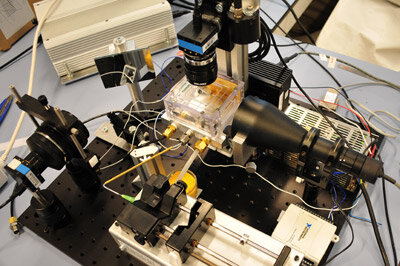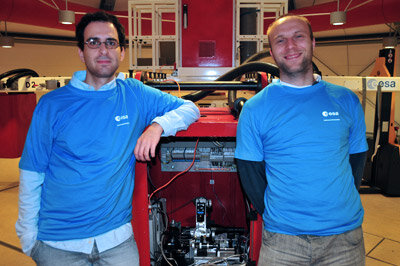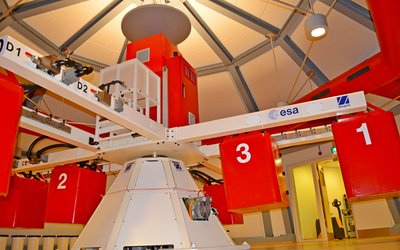Meet the teams: HyperDrop
Four teams of university students were selected to develop and perform their hypergravity experiments during ESA's 'Spin your Thesis!' 2011 campaign. Here is an introduction to the Italian and Belgian team.
![]()
![]()
Behaviour of a liquid droplet on a flat, solid surface
![]()
![]()
| Universities |
Université Libre de Bruxelles Politecnico di Milano |
| Endorsing professor |
Oleg Kabov Microgravity Research Center, ULB |
| Assistant professor |
Dmitry Zaitsev Microgravity Research Center, ULB |
| Team | Luca Valdarno, Nicolas Freuville |

The HyperDrop team was composed of two students, one from the Politecnico di Milano (Italy) and the other from the Université Libre de Bruxelles (Belgium). The experiment aimed to reproduce and investigate the effect of gravity on static and dynamic advancing contact angles. A contact angle is the angle at which a liquid/vapour interface meets a solid surface.
Liquid droplet spreading is a very common phenomenon in various natural and industrial processes, e.g. thermal management and combustion systems. Although there are numerous investigations on sessile droplets in the scientific literature, only a few of these have been performed at different gravity levels.
When a liquid droplet is placed on a solid surface, three interfaces form, due to the presence of three phases (solid, liquid, and vapour). These interfaces occur at the boundaries between each phase couple: solid/vapour, solid/liquid and liquid/vapour. A force balance at the triple point determines the wettability – the preference of the solid to contact the liquid in the presence of the vapour.

In the HyperDrop experiment, different smooth and rough surfaces were used, with different contact angles (CAs) and different contact angle hysteresis (CAH) - the difference between the advancing and receding CAs. The liquid used was distilled, deionised, nano-filtered water. The main variable parameters were: gravity level, droplet volume, liquid flow rate, CAH and CA.
The experiment was conducted at ambient temperature and pressure, and at various gravity levels. The liquid droplet was generated on the changeable surface of the test cell by using a syringe pump. The shape of the droplet was recorded by two high-resolution CCD cameras, using the shadow technique.
Numerical algorithms for a solution of the Young-Laplace equation, which describes the shape of sessile droplets, were developed and tested for different initial conditions. A set of direct and inverse problems could be solved on determination of the capillary length and CA from the measured values of droplet dimensions: height, diameter, wetted spot diameter and volume.
For the first time the spreading of a sessile droplet under the effect of gravity was experimentally observed on surfaces with low CAH and high CAH.
Read the final experiment report here.






